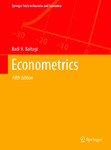Econometrics
Abstract
This book is intended for a first year graduate course in econometrics. I tried to strike a balance
between a rigorous approach that proves theorems, and a completely empirical approach where
no theorems are proved. Some of the strengths of this book lie in presenting some difficult
material in a simple, yet rigorous manner. For example, Chapter 12 on pooling time-series of
cross-section data is drawn from my area of expertise in econometrics and the intent here is to
make this material more accessible to the general readership of econometrics.
This book teaches some of the basic econometric methods and the underlying assumptions
behind them. Estimation, hypotheses testing and prediction are three recurrent themes in
this book. Some uses of econometric methods include (i) empirical testing of economic theory,
whether it is the permanent income consumption theory or purchasing power parity, (ii)
forecasting, whether it is GNP or unemployment in the U.S. economy or future sales in the computer
industry. (iii) Estimation of price elasticities of demand, or returns to scale in production.
More importantly, econometric methods can be used to simulate the effect of policy changes
like a tax increase on gasoline consumption, or a ban on advertising on cigarette consumption.
It is left to the reader to choose among the available econometric/statistical software to use,
like EViews, SAS, Stata, TSP, SHAZAM, Microfit, PcGive, LIMDEP, and RATS, to mention
a few. The empirical illustrations in the book utilize a variety of these software packages but
mostly with Stata and EViews. Of course, these packages have different advantages and disadvantages.
However, for the basic coverage in this book, these differences may be minor and more
a matter of what software the reader is familiar or comfortable with. In most cases, I encourage
my students to use more than one of these packages and to verify these results using simple
programming languages like GAUSS, OX, R and MATLAB.
This book is not meant to be encyclopedic. I did not attempt the coverage of Bayesian
econometrics simply because it is not my comparative advantage. The reader should consult
Koop (2003) for a more recent treatment of the subject. Nonparametrics and semiparametrics
are popular methods in today’s econometrics, yet they are not covered in this book to keep
the technical difficulty at a low level. These are a must for a follow-up course in econometrics,
see Li and Racine (2007). Also, for a more rigorous treatment of asymptotic theory, see White
(1984). Despite these limitations, the topics covered in this book are basic and necessary in the
training of every economist. In fact, it is but a ‘stepping stone’, a ‘sample of the good stuff’ the
reader will find in this young, energetic and ever evolving field.
I hope you will share my enthusiasm and optimism in the importance of the tools you will
learn when you are through reading this book. Hopefully, it will encourage you to consult the
suggested readings on this subject that are referenced at the end of each chapter. In his inaugural
lecture at the University of Birmingham, entitled “Econometrics: A View from the Toolroom,”
Peter C.B. Phillips (1977) concluded:
Collections
- School of Business [43]

